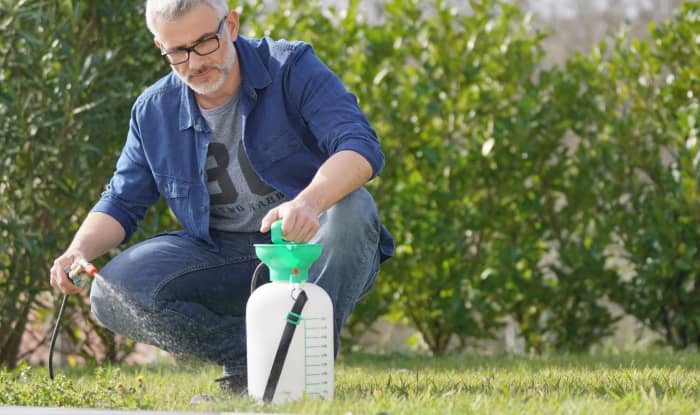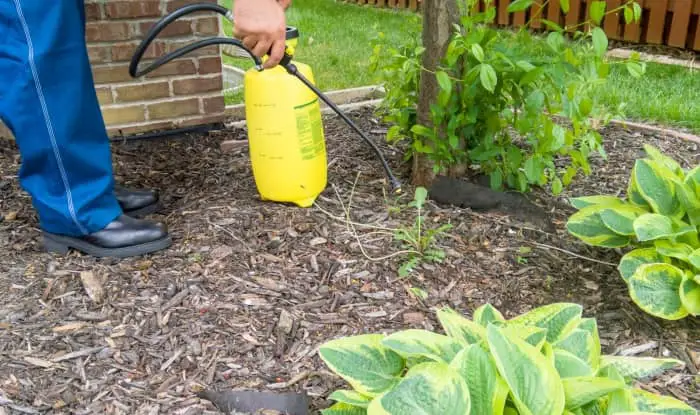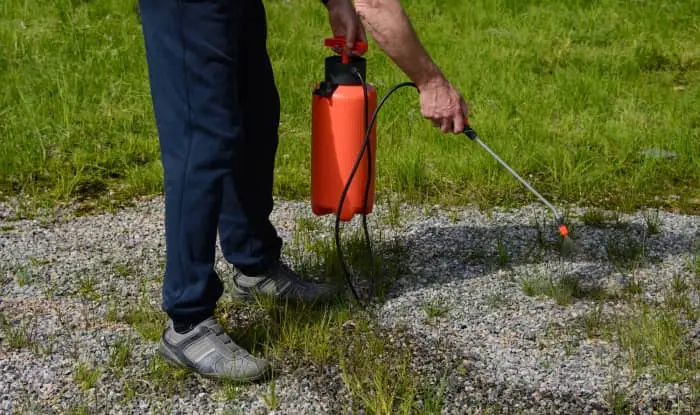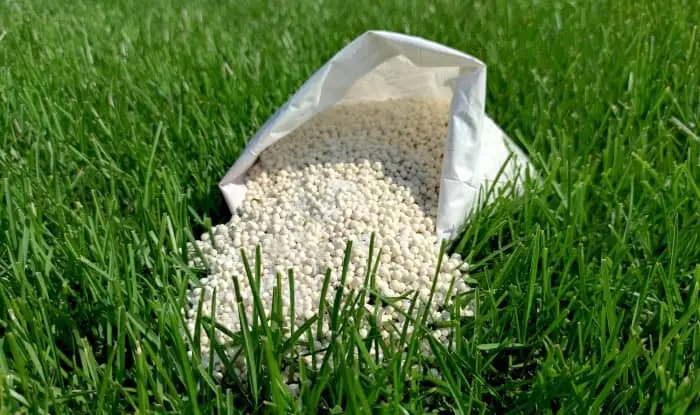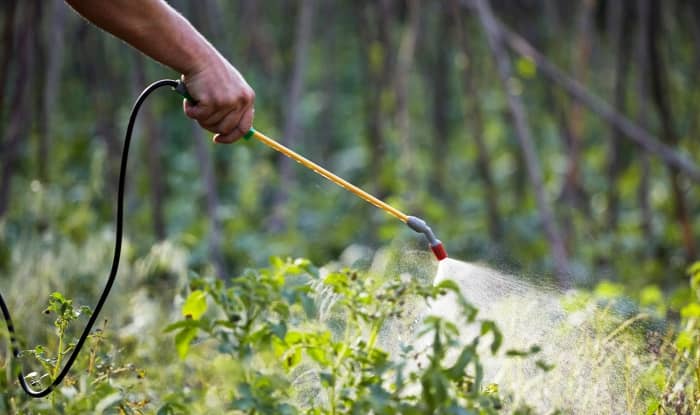If weeds are growing in your yard, then you need a post-emergent herbicide.
But there are many different types of post-emergent herbicides. And each type works differently and suits a different weed situation.
So in this article, we take a look at each type and what they do. And I’ll give you advice on choosing the right one.
Let’s dive in.
What Are Post-emergent Herbicides?
You can use post-emergent herbicides to kill weeds already growing above ground. But they don’t prevent weed seeds from developing. To kill seedlings before they grow through the topsoil, you need a pre-emergent herbicide.
Using a post-emergent herbicide can help you control existing weeds. By killing the weeds before they have a chance to spread by seeds or rhizomes, you can prevent the future growth of weeds in your yard.
Types of Post-Emergent Weed Killers
There are many different types of post-emergent weed killers, and choosing the right one for your situation is essential to getting satisfactory results. Let’s take a look at the different types and their different properties:
Systemic Post-emergent Herbicides
When you apply a systemic post-emergent herbicide, the weed absorbs it through its leaves. The herbicide is then translocated to the roots, attacking the weed from the inside.
Systemic herbicides interfere with cellular division and enzymatic function, vital processes for the plant. And because systemic herbicides can kill the roots, they prevent the weed from regrowing.
But patience is needed when using a systemic herbicide. It takes time for the herbicide to translocate around the circulatory system of the weed, often taking two or three weeks to kill the plant. With particularly stubborn weeds, you may need to apply the herbicide again.
Contact Post-emergent Herbicides
Contact post-emergent herbicides work immediately after you spray them on the weed (1). You can see the results very quickly, often within hours.
But because contact herbicides affect the parts of the plants they touch, they are less likely to kill the roots than a systemic herbicide, and the weeds might regrow. And you may have to apply the herbicide repeatedly.
But by killing the foliage, you can prevent the weed from photosynthesizing. And by using the contact herbicide each time the weed regrows, you will eventually exhaust the root system, and the weed will die. Makes sure you reapply the treatment before the weed grows new leaves.
Contact herbicides work best on small annual weeds. And are less effective against perennial weeds with deep and extensive root systems.
Selective Post-emergent Herbicides
Selective post-emergent herbicides target specific types of weeds (2). You can use selective herbicides to control broadleaf weeds and certain types of grasses, such as crabgrass and annual bluegrass (Poa annua). Common lawn grasses are not usually affected, so the best herbicides for lawns are selective herbicides.
But selective herbicides sometimes harm turfgrass. You should check the product label to ensure the herbicide is safe to use on your type of turfgrass. You should also check that the herbicide can kill the weeds you’re struggling with.
Examples of selective post-emergent herbicides include atrazine and 2,4-D amine.
Non-selective Post-emergent Herbicides
Non-selective herbicides kill any plants that you apply them to. They’re a good choice for killing weeds in locations where you don’t want any vegetation to grow, such as driveways, sidewalks, car parks, patios, and around building foundations. They’re also good for killing all the plants in an area so you can start again and replant.
But non-selective herbicides are not a good choice for using on your lawn or around desirable plants. If you use them for the spot treatment of weeds around your garden, then you must be careful. It’s a good idea to use a piece of cardboard to shield desirable plants while spraying a non-selective herbicide.
Non-selective herbicides can be contact or systemic herbicides.
Liquid Post-emergent Herbicides
You need to mix liquid herbicides with water then apply them to weeds using a sprayer. You can use a handheld sprayer, hose-end sprayer, or tank sprayer.
You can cover large areas quickly when spraying liquid herbicides. But they can be difficult to use in flowerbeds because the herbicide is more likely to drift onto the plants, causing them harm.
Some people find it easier to get even coverage of their lawn when spraying a liquid post-emergent. And you can add an indicator dye to your herbicide to make it easy to see the sprayed areas.
Some liquid herbicides include a surfactant that helps the herbicide stick to the weed, maximizing uptake and improving results.
Granular Post-emergent Herbicide
Granular herbicides come in small pellets or granules. You spread the granules using either a broadcast spreader or a handheld spreader. To get an even application over the treated area, you need to walk up and down slowly. It’s usually easy to see where you have already applied the granules.
Some people find granular herbicides easier to use for weed control around flowers and shrubs in garden beds because it’s easier to prevent the herbicide from getting on the plants.
Common Chemicals In Post-emergent Herbicides
There are many different chemicals used as post-emergent herbicides. Each chemical fits into selective, non-selective, systemic, or contact herbicides.
Post-emergent weed killers sometimes contain more than one chemical herbicide to increase the range of weeds they kill, their effectiveness, and the speed of results.
Let’s take a look at some of the most common types of post-emergent herbicides.
Post-emergent herbicide list:
Dicamba
Dicamba is a systemic and selective broadleaf herbicide that provides control of weeds such as dandelion, thistle, spurge, and clover.
Dicamba kills weeds by causing abnormal plant growth.
Glufosinate
Glufosinate is a contact and non-selective herbicide that also has some systemic action. Glufosinate is a broad-spectrum herbicide that kills broadleaf and grassy weed species. You can also use this herbicide to control morning glory and yellow nutsedge.
Glufosinate works by inhibiting plant enzymes, preventing photosynthesis.
Glyphosate
Glyphosate is well-known as the chemical in RoundUp. Glyphosate is a non-selective and systemic herbicide that kills all types of plants.
It works by inhibiting a plant enzyme involved in amino acid synthesis.
Fluazifop
Fluazifop is a systemic and selective herbicide that controls annual and perennial grasses but doesn’t kill broadleaf weeds. You can use fluazifop to kill crabgrass, Poa annua, quackgrass, goosegrass, and johnsongrass.
Fluazifop works by disrupting lipid synthesis, causing plant cells to die.
Bentazon
Bentazon is a selective, contact herbicide. You can use bentazon to control many species of annual broadleaf weeds and sedges, as well as yellow nutsedge (a perennial).
Bentazon works by inhibiting photosynthesis.
Monosodium Methanearsonate
Monosodium methanearsonate (MSMA) is a selective, contact herbicide. You can use MSMA to control many kinds of grassy and broadleaf weeds.
MSMA works by disrupting cell membranes.
Natural Post-emergent Herbicides
If you don’t want to use synthetic chemicals, you can use natural post-emergent herbicides instead. Examples include high-strength vinegar and d-limonene (from citrus oil). These weed killers are pet-friendly, so some gardeners prefer using them.
How To Choose A Post-emergent Herbicide For Your Lawn
Here are some things to consider when choosing the best post-emergent herbicide to use in your yard:
- What types of weeds do you need to kill?
- How big an area are you looking to treat?
- Are you looking to kill all plants in the area?
- Are there plants and grass that you don’t want to harm?
Answering these questions will help you choose the right weed killer type for your situation, so you can get better results and save time and money.
Reference:
- Contact Herbicides – https://acis.cals.arizona.edu/agricultural-ipm/vegetables/vipm-archive/vipm-weeds-view/contact-herbicides
- Distinguish Between Selective And Non-selective Herbicides And Give An Example Of Each – https://forages.oregonstate.edu/nfgc/eo/onlineforagecurriculum/instructormaterials/availabletopics/weeds/herbicides
